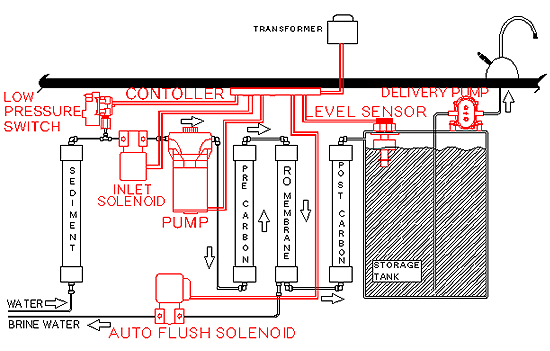|
|
|
|
| |
|
|


- Low Pressure Switch(LPS)
-
Should be installed
after the sediment filter and before
Inlet Solenoid and Pump. Uses
a micro switch to signal when inlet
pressure is below 5psi. Used
to prevent the system from continuous
operation that can happen when the
water supply is stopped. Without
the LPS, if the inlet supply is
interrupted the system will continue
to operate because the storage tank
will not fill (not making water)
and therefore not provide an 'OFF'
signal for the system.
- Inlet Solenoid
- The Inlet, or Main Solenoid opens
at start of filtration cycle and closes
at end of filtration cycle.
- Pressure Boost Pump
- Used in areas where the source
water pressure is below 50psi. The
Pressure Boost Pump provides a constant
70+psi for optimum membrane performance.
Pump model varies depending
on membrane specification.
- Controller (PCB)
- The PCB Controller integrates all
the electronic functions of the system.
It operates the system based
on two sensor inputs, typically the
Low Pressure Switch and Level Sensor.
Based on signals from these
two sensors, the PCB opens and closes
the Inlet Solenoid and Auto Flush
Solenoid, and starts and stops the
Pressure Boost Pump.
- Float Level Sensor
- In the case of an atmospheric tank,
a level sensor must be used to indicate
tank level to start and stop the system
operation. Float Level Sensors
are available in side mount or vertical
mount. Vertical mount can be
either Dual or Single Float.
- Auto Flush Solenoid
- The Auto Flush Solenoid is controlled
either by the PCB or the Auto Flush
Circuit. When the solenoid is
closed the brine passes through an
orifice that is sized according to
the membrane specification which restricts
the brine flow for normal operation.
At the beginning of each filtration
cycle, the Solenoid will open allowing
free brine flow to flush the membrane
surface.
- Delivery Pump
- The Delivery pump is
used to transfer water from the holding
tank to the point of use. Deliver
pump operation is controlled either by
a High Pressure Switch attached in between
the pump and the spigot, or by an on/off
switch on the spigot.
|
|
|
|
|
|
|
|
|
|
